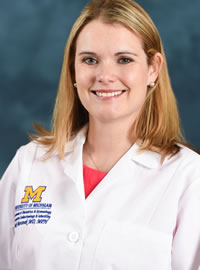Future Families
Fertility Preservation Program offers hope and options to patients of reproductive age
Cancer treatment can impact fertility in women and men. However, many young cancer patients are not yet thinking about starting a family or are focused on treatment and getting well. As the rate of younger patients who survive cancer increases, studies show they often regret not having more information on steps to preserve their fertility. We sat down with two key members of Michigan Medicine’s Fertility Preservation Program. Molly Moravek, M.D., MPH, is the medical director. Erin Ellman, LMSW, is the fertility preservation coordinator. Together they work to preserve fertility in reproductive-aged men and women being treated at the Rogel Cancer Center.


Q: What is the link between cancer and losing the ability to have children?
MM: The most common way is damage to a woman’s eggs or a man’s sperm. This can happen as a result of chemotherapy treatment or radiation to the testes or ovaries. Some cancer patients have to have reproductive organs surgically removed.
Bone marrow transplants especially affect fertility because of the high doses of chemotherapy and total body radiation that are often needed ahead of the transplant.
Much of the effect depends on the specific chemotherapy agents and the dose. The more cycles of treatment, the greater the risk of infertility. Some chemo agents are more toxic to the ovaries and testes than others. A woman’s age and how many eggs she has left before starting chemotherapy can also affect her infertility risk.
Q: What are the treatment options to preserve fertility in women?
MM: One option is a drug called Lupron to trick the ovaries into thinking they’re in menopause so they won’t be as susceptible to damage from chemotherapy. It is available in a one-month or three-month injection that takes place before cancer treatment begins. After the medication wears off, if she still has ovarian function, the woman’s period will return.
Another option is to freeze eggs or embryos that can be stored and used at a later time. There is no difference between frozen eggs versus fresh eggs so there is no need to create embryos with a sperm donor or an uncertain partner. The process only takes two weeks so there are minimal delays to treatment. Eggs and embryos can be frozen indefinitely.
A newer and more experimental technique involves removing and freezing ovarian tissue before treatment and reintroducing it after treatment. There have been some promising studies. We currently refer patients to nearby institutions in Chicago, Pittsburgh or Cincinnati. We hope to offer this procedure at Michigan Medicine in the near future.
Q: What are the treatment options to preserve fertility in men?
MM: Fertility preservation is much simpler. Most men can donate and bank a sperm sample before or soon after beginning treatment for cancer, even if they are admitted to the hospital. There are also procedures to extract sperm for banking until later use.
Q: What are third-party reproduction options?
MM: These are options patients and families can pursue if a patient does not have ovarian or testicular function after cancer treatment. It is possible for people to use donor eggs, embryos or sperm. Also, in women who cannot carry a pregnancy, they can use a gestational carrier. Adoption is another option.
Q: Erin, what is your role as fertility preservation coordinator?
EE: Providers at the Rogel Cancer Center contact me about their patients. I guide patients through the fertility preservation process. I’ll meet with patients to provide education on risks and available options, schedule appointments and coordinate their care, and provide support.
I also discuss costs and help connect patients to financial resources that are available for fertility preservation. Patients can come to me anytime throughout the process. We always circle back with the cancer center provider to be sure they’re comfortable with the options a patient has selected.
Q: How do you make the fertility preservation process easier for patients?
EE: We aim to integrate fertility preservation as seamlessly as possible into the cancer treatment plan. For some patients, hearing they have a risk of infertility is just as devastating as the actual cancer diagnosis. It’s important that patients receive information on fertility preservation as early as possible in order to maximize their options and minimize the delay in beginning cancer treatment.
I’m right at the cancer center so I can often come to a patient’s clinical appointment to start the discussion. Our program has a direct phone line, email address and pager so we can be easily reached.
I coordinate fertility preservation appointments around cancer treatment so patients don’t have to make extra trips to Ann Arbor. I help with front-end paperwork, making sure the right tests are ordered and avoiding delays for patients.
Q: What do you tell new patients who are concerned that cancer treatment will hurt their chances to have a family?
EE: The most rewarding part of my role is hearing a patient say that learning about fertility preservation has given them hope. Even when a patient doesn’t choose fertility preservation, they often say they feel better knowing they were able to make an informed choice.
I try to approach patients with a hopeful yet realistic picture of their risks and what we can offer. There are no right or wrong answers when deciding what course is best for them. And, there are many ways to build a family.
It’s also important to validate the grief patients experience as they adjust to the idea that their paths to building a family might be different than they envisioned. Every situation is different so every conversation is different based on what the patient and family needs.
If you are a patient at the Rogel Cancer Center, call 734-232-9170 to speak with a fertility preservation coordinator.
Are you interested in supporting the work of the Fertility Preservation Program? Use our online form to donate to the program.
Continue reading the Spring, 2018 issue of Thrive.
Learn more about cancer treatment and fertility preservation:
